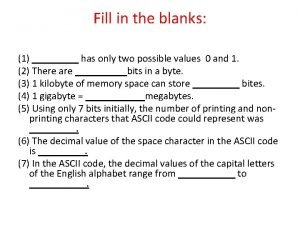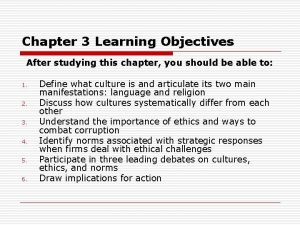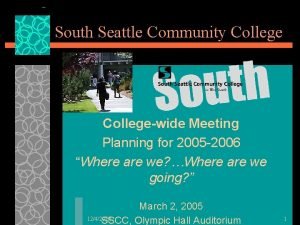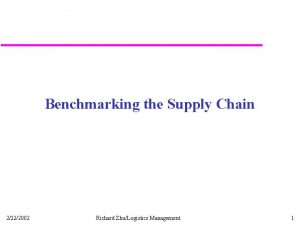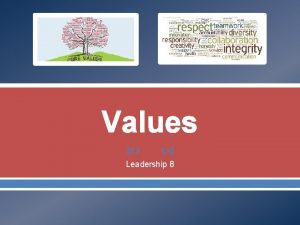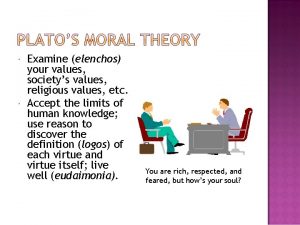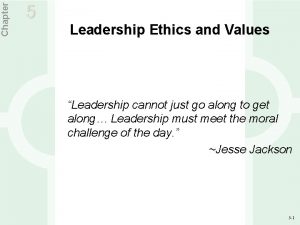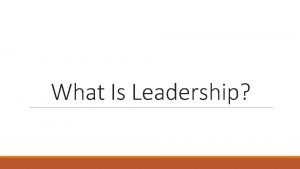Leadership Values Values vs Priorities Priorities o A























- Slides: 23

Leadership Values

Values vs Priorities

Priorities o A thing that is regarded as more important than another o Fact or condition of being regarded or treated as more important

Values o Lasting beliefs or ideals o A major influence on behavior and attitude o Serves as broad guidelines in all situations

Leadership: Control vs. Influence Control • • the power to influence or direct people's behavior “the whole operation is under the control of a supervisor” Influence • the capacity to have an effect on the character, development, or behavior of someone • action or process of producing effects on the actions, behavior, opinions, of another or others

Leadership is about influence not control • “If I could control these people, I could guarantee the results. ” • The truth is that control is an illusion. • You can’t control anyone, even the people that report to you.

Leadership is about influence not control • To be an effective leader, it is necessary to influence others to support and implement decisions that the leader and group members perceive are necessary. • Leadership is the act of influencing outcomes.

Types of Influence Tactics • Choice of influence tactics; in terms of “soft” versus “hard” How much freedom a tactic leaves the person to decide either to commit or to resist

Tactic Definition Effectiveness Pressure Behavior includes demands, threats or intimidation to convince others to comply with a request or to support a proposal. Low Assertiveness Behavior includes repeatedly making requests, setting timelines for project completion or expressing anger toward individuals who do not meet expectations. Low Legitimating Behavior seeks to persuade others that the request is something they should comply with given their situation or position. Low Coalition Behavior seeks the aid of others to persuade them to do something or uses the support of others as an argument for them to agree. Low Exchange Behavior makes explicit or implicit a promise that others will receive rewards or tangible benefits if they comply with a request or reminds others of a favor that should be reciprocated. Moderate

Ingratiating Behavior seeks to get others in a good mood or to think favorably Moderate of them before asking them to do something. Rational Persuasion Behavior uses logical arguments and factual evidence to persuade others that a proposal or request is viable and likely to result in task objectives. Moderate Personal Appeals Behavior seeks others’ compliance to their request by asking a “special favor for them, ” or relying on interpersonal relationships to influence their behavior. Moderate Inspirational Behavior makes an emotional request or proposal that arouses enthusiasm by appealing to other’s values and ideals, or by Appeals High Consultation Behavior seeks others’ participation in making a decision or High increasing their confidence that they can succeed. planning how to implement a proposed policy, strategy or change.

Outcomes of Influence Attempts • Resistance • Compliance • Commitment

Resistance: Person resists your efforts to influence his or her behavior Either avoids, ignores or actively resists your efforts at influence • Refuse outright to agree to your attempts to influence them • Ignore your efforts at influence • Make excuses why they cannot do what you want • Ask higher authorities to overrule your request • Attempt to persuade you to withdraw your attempt at influence

Compliance: Person accepts your influence attempt “ but apathetically or unenthusiastically” • Can be successful in influencing behavior • But not the attitudes of your influence target

Commitment: Person agrees with your decision or influence • Makes an enthusiastic, voluntary effort to do what you have asked • Not because the person has to but because he or she wants to

Control vs. influence Cannot control only influence • Have to exhibit the right behavior to influence • You have to model the behavior you expect

"Why Do We Lie?

Job Briefings Ask questions • Get input • Listen • Influence • Allow individuals to think through the situation • Take ownership [all involved] • Commitment [our problem our solution]

Resources Anita Hall, Extension Educator Leverne Barrett, Extension Leadership Specialist University of Nebraska Neb. Guide For more information on influence tactics check any of the following publications: Barbuto, J. and Scholl, R. (1999). Leaders’ motivation and perception of followers’ motivation as predictors of influence tactics used. Psychological Reports, 84, 1087 -1098. French, J. P. R. and Raven, B. (1959). The bases of social power. In D. Cartwright (Ed. ), Studies in social power (7 th ed. ). Ann Arbor: University of Michigan, Institute for Social Research. Fritz, S. , Brown, W. , Lunde, J. and Banset, E. (1999). Interpersonal skills for leadership (2 nd ed. ). Upper Saddle River, NJ: Prentice Hall. Hughes, R. , Ginnett, R. and Curphy, G. (1995). Power, influence and influence tactics. In The Leader’s Companion. , J. Thomas Wren. New York, NY. : The Free Press. Kipnis, D. (1976). The powerholders. Chicago: University of Chicago Press. Yukl, G. A. (1998). Leadership in organizations (4 th ed. ). Englewood Cliffs, NJ: Prentice Hall. Yukl, G. and Falbe, C. (1990) Influence tactics and objectives in upward, downward and lateral influence attempts. Journal of Applied Psychology, 75, 132 -140. Leadership as an Influence Process | Leadership www. leadersdirect. com/leadership-as-an-influence-process Vitalsmarts. com

KEY TAKE AWAYS LYING • In terms of safety, i. e. Understanding job briefing • Is it lying?

TRADING MORALITY What do we trade for at the time of decision? • Time – may be faster • Easier • Comfort • Priorities vs Values

AUDITING • Less Judging • More Alerting • Self Moral Wake-up call Bring Morals to the fore front

SELF AUDITING Outcomes • What would you give to turn back time? • What would you have done prior? • The decision you make before affects the CONSEQUENSES - Good and Bad

EDUCATION EMPOWERMENT OWNERSHIP ASK QUESTIONS LISTEN COMMITMENT
 Transformational vs transformative leadership
Transformational vs transformative leadership Adaptive leadership theory
Adaptive leadership theory Enthusiastic beginner disillusioned learner
Enthusiastic beginner disillusioned learner What is the concept of human values
What is the concept of human values Instumental values
Instumental values Instrumental values
Instrumental values A bit can have two possible values. what value are those?
A bit can have two possible values. what value are those? Western vs eastern values
Western vs eastern values A link between relationships chapter 14
A link between relationships chapter 14 Priorities
Priorities Ampdu priorities
Ampdu priorities Boy scouts wilderness survival
Boy scouts wilderness survival Goals and priorities
Goals and priorities Wood badge ticket vision examples
Wood badge ticket vision examples Volkswagen of america: managing it priorities
Volkswagen of america: managing it priorities Www.xkcd.com
Www.xkcd.com Supplier and distributor benchmarking
Supplier and distributor benchmarking Cross curricular priorities
Cross curricular priorities Ggt 2030 logo
Ggt 2030 logo Goals and priorities
Goals and priorities 6 quality priorities
6 quality priorities National core standard
National core standard Thread priorities
Thread priorities Preferred priorities for care
Preferred priorities for care






